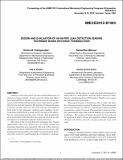| dc.contributor.author | Chatzigeorgiou, Dimitrios | |
| dc.contributor.author | Ben Mansour, Rached | |
| dc.contributor.author | Khalifa, Atia | |
| dc.contributor.author | Youcef-Toumi, Kamal | |
| dc.date.accessioned | 2017-05-16T16:02:51Z | |
| dc.date.available | 2017-05-16T16:02:51Z | |
| dc.date.issued | 2012-11 | |
| dc.identifier.isbn | 978-0-7918-4520-2 | |
| dc.identifier.uri | http://hdl.handle.net/1721.1/109110 | |
| dc.description.abstract | Leakage is the major factor for unaccounted fluid losses in almost every pipe network. In most cases the deleterious effects associated with the occurrence of leaks may present serious economical and health problems and therefore, leaks must be quickly detected, located and repaired. The problem of leakage becomes even more serious when it is concerned with the vital supply of fresh water to the community. Leaking water pipelines can develop large health threats to people mostly because of the infiltration of contaminants into the water network. Such possibilities of environmental health disasters have spurred research into the development of methods for pipeline leakage detection. Most state of the art leak detection techniques have limited applicability, while some of them are not reliable enough and sometimes depend on user experience. Our goal in this work is to design and develop a reliable leak detection sensing system. The proposed technology utilizes the highly localized pressure gradient in the vicinity of a small opening due to leakage in a pressurized pipeline. In this paper we study this local phenomenon in detail and try to understand it with the help of numerical simulations in leaking pipelines (CFD studies). Finally a new system for leak detection is presented. The proposed system is designed in order to reduce the number of sensing elements required for detection. The main concept and detailed design are laid out. A prototype is fabricated and presented as a proof of concept. The prototype is tested in a simple experimental setup with artificial leakages for experimental evaluation. The sensing technique discussed in this work can be deployed in water, oil and gas pipelines without significant changes in the design, since the concepts remain the same in all cases. | en_US |
| dc.description.sponsorship | King Fahd University of Petroleum and Minerals (Project Number R7-DMN-08) | en_US |
| dc.language.iso | en_US | |
| dc.publisher | American Society of Mechanical Engineers | en_US |
| dc.relation.isversionof | http://dx.doi.org/10.1115/IMECE2012-87493 | en_US |
| dc.rights | Article is made available in accordance with the publisher's policy and may be subject to US copyright law. Please refer to the publisher's site for terms of use. | en_US |
| dc.source | American Society of Mechanical Engineers (ASME) | en_US |
| dc.title | Design and Evaluation of an In-Pipe Leak Detection Sensing Technique Based on Force Transduction | en_US |
| dc.type | Article | en_US |
| dc.identifier.citation | Chatzigeorgiou, Dimitris M., Rached Ben-Mansour, Atia E. Khalifa, and Kamal Youcef-Toumi. “Design and Evaluation of an In-Pipe Leak Detection Sensing Technique Based on Force Transduction.” Volume 4: Dynamics, Control and Uncertainty, Parts A and B (November 9, 2012). | en_US |
| dc.contributor.department | Massachusetts Institute of Technology. Department of Mechanical Engineering | en_US |
| dc.contributor.mitauthor | Chatzigeorgiou, Dimitrios | |
| dc.contributor.mitauthor | Ben Mansour, Rached | |
| dc.contributor.mitauthor | Khalifa, Atia | |
| dc.contributor.mitauthor | Youcef-Toumi, Kamal | |
| dc.relation.journal | Volume 4: Dynamics, Control and Uncertainty, Parts A and B | en_US |
| dc.eprint.version | Final published version | en_US |
| dc.type.uri | http://purl.org/eprint/type/ConferencePaper | en_US |
| eprint.status | http://purl.org/eprint/status/NonPeerReviewed | en_US |
| dspace.orderedauthors | Chatzigeorgiou, Dimitris M.; Ben-Mansour, Rached; Khalifa, Atia E.; Youcef-Toumi, Kamal | en_US |
| dspace.embargo.terms | N | en_US |
| dc.identifier.orcid | https://orcid.org/0000-0002-5382-0809 | |
| mit.license | PUBLISHER_POLICY | en_US |
| mit.metadata.status | Complete | |
